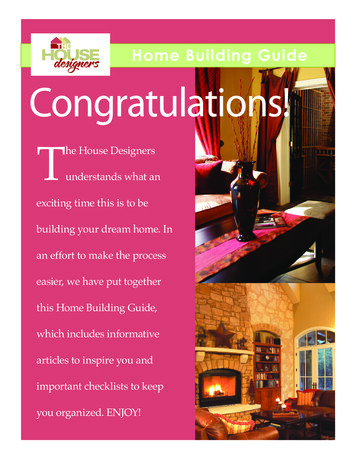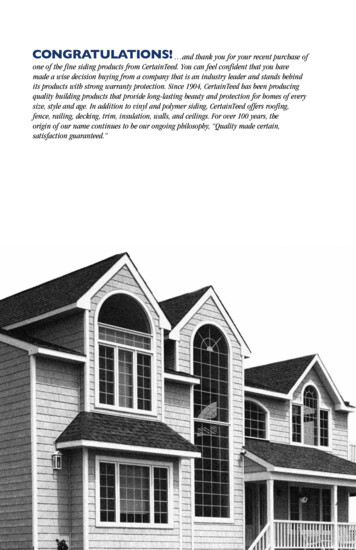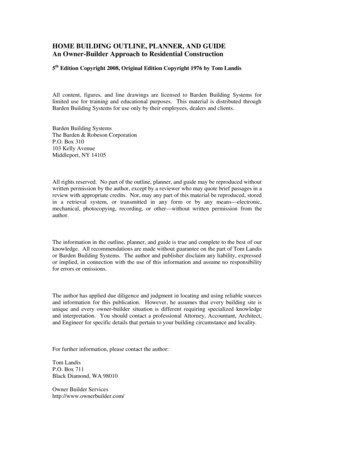
Transcription
Home Building GuideCongratulations!The House Designersunderstands what anexciting time this is to bebuilding your dream home. Inan effort to make the processeasier, we have put togetherthis Home Building Guide,which includes informativearticles to inspire you andimportant checklists to keepyou organized. ENJOY!
Ta b l e o f C o n t e n t sFEATURED ARTICLESStep-by-Step Home Building Guide .p. 3Homes Designed With Women In Mind .p. 5All About Flexible Living Spaces . p. 7Matching The Right Window To The Right House Style . p. 8Top 10 Time-Saving Moving Tips . p. 10Energy-Efficient Windows . p. 12The Latest Kitchen Styles . p. 14Painting 101 . p. 16Tips for Designing Your Garage . p. 17Designing Your Bathroom . p. 18WORK SHEET ORGANIZERSStep 1: Realizing Your Dream Buying LandFinancingHome PlansStep 2: Before You Build Product Summary AllowanceExteriorInteriorYardscapeSystemsStep 3: Building Your House Builders & BiddingStep 4: Moving In Managing the MoveIf you any questions, please call 1-866-214-2242 or for more greatinformation and articles visit us at:www.TheHouse Designers.com
Step-byStep Home Building GuideSo, you’re thinking about building a new home! This isone of the most exciting ventures of a lifetime. We’ve puttogether this step-by-step home building guide to helpyou understand the different building phases and how itall comes together. You’ll see the whole process in one snapshot toguide you through selecting your dream house plan all the way tothe finishing stages.Don’t forget to check out all of our other helpful articles likeFinding a Home Plan and Green Building if you’re thinking aboutbuilding an ENERGY STAR home in our Product Ideas section dedicated to providing you building tips andproduct ideas to make your home building experience easier.1CHOOSING A PLAN: Choosing the right house plan can be an exciting experience if you know whatto look for and prioritize your needs. As you begin your search, be sure to look for features that fit yourlifestyle, lot and budget. You’ll want to carefully check the design and size of each room, especially thekitchen, master suite and great room — since these are the most lived in areas of a home. The trend is towardsa more casual, open floor plan, which allows you to easily customize your dream home.2FOUNDATION: The foundation is a critical element of the building process, and it must be done correctly to prevent problems further down the road. Your lot needs to be cleared and adjusted (i.e. fill dirtbrought in, leveling, etc.) to prepare the space for your new home. Next, form boards will be put upwhich serve as a mold for the foundation. After plumbing lines are put in place, the foundation is poured andyou’ll be able to see your home’s footprint.3FRAMING: After the foundation has been poured and has set up, the form boards are removed andframing of the house begins. Much as our skeleton serves as the structure for our bodies, the frame of ahouse is the underlying structure of the home. As the framing progresses, you will see the layout of yourhome unfold, and you’ll be able to identify different rooms, doorways, and windows. If your home seemssmaller than you imagined at this point, don’t panic. It is simply an illusion!456INSPECTIONS: Inspections are a very important part of the home construction process, for it ensuresthat every element of the building is done correctly. After the foundation is poured and the framing iscompleted, your town or city will send an inspector out to view the progress. He or she will check theframing and the mechanical components of the home, making sure they are up to code and installed properly.FRAMEWALK: After the first inspections, your builder will invite you to walk through your home. Atthis point you will be able to visualize more easily what your dream home will look like. At this point, allwalls and trusses will be framed, and the roof sheathing will be installed. Another framing inspection willalso take place.ENCLOSING YOUR HOME: Once the framing has undergone inspection, your builder will beginenclosing your home. At this point in the construction process your builder will install exterior sheathing,shingles, the roofing system, windows and doors. Since windows and doors are one of the most visiblefeatures of your home from both the inside and out, you’ll want to carefully select the perfect doors andwindows for your new home. Make sure your windows have the performance, durabilty and energy efficiencythat your particular geographical location warrants. And look for windows that have tax credits that couldsave you up to 1,500.-3-Continued.
Step-by-Step Home Building Guide78HOUSE WRAP: Certain climates offer a higher risk of moisture, mold and wood rot occurring in thehome. Therefore, a protective barrier known as a house wrap is installed to prevent the structure of yourhome and its interior from getting wet. The house wrap ensures that all moisture will remain outside thehome.MECHANICAL INSTALLATION: This stage is very critical and occurs before the installation of thesheet rock. It is at this point that all mechanical components and wiring is installed. It is incrediblyimportant that everything be installed correctly, since it will soon be covered by sheetrock and will bemuch less accessible. At this point, you may want to consider having a home fire sprinkler system or homeentertainment system installed. During this stage, plumbing and mechanical components will be roughedin. Venting, ductwork, a water heater, and the HVAC system will be installed. Any exterior finishes, such asmasonry and wood, will be installed at this point, as well.910INSULATION: Insulation is a critical factor in determining your home’s energy and cost efficiency. Wheninstalled adequately and properly in your home’s floors, walls, and ceilings, this relatively inexpensiveproduct can save you large amounts of money throughout the life of your home, simply by preventingheat from escaping your home. Best of all, this product is maintenance free!SHEETROCK: Once your home is framed and wrapped, and all the mechanicals have beeninstalled, the sheetrock is put in place to form the walls. Your builder will be able to assist you indeciding the thickness of sheetrock you want to use, and if you want to use screws or nails to fastenit to the studs and joists. You may also want to consider what type of texture and paint to use on your walls toachieve your desired effect.11INTERIOR WORK: Once all of the major structural components have been installed, it is time tomove to the more decorative details of the home. This includes cabinets and countertops, interiordoors, fireplaces, moldings, staircase balusters and railings, and base and door trim. The phasebasically includes choosing and installing every element that transforms your house from a structure into ahome!12FINISHING STAGES: As you approach the final stages of the home building process, you areprobably experiencing excitement, anticipation, and maybe even a little anxiety. All of theseemotions are understandable, because by now, you are seeing all of the hard work that has goneinto the process take shape, and the final product, your dream home, is finally within reach! It is at this pointthat your home develops its personality through your choices of lighting fixtures, bathroom accessories andfixtures, window treatments and more. It is only a short time from now that you can unload the moving truckand settle into your new home!-4-
Homes Designed With Women In MindFrom the cozy living room filled with pictures andkeepsakes to the sweet smells of a home cooked dinner ina well-designed kitchen to the worn rocking chair in thecorner of a master suite overlooking the backyard - theseare just a few of the special ways moms turn houses intohomes.It is no surprise that when it comes to building a homeand selecting a house plan that over 60% of house plansare bought by woman. They know how much space theyneed in their new home to make it functional, yet appealto their tastes. They know exactly what they need - a largekitchen with cooking area and breakfast counter, lots ofstorage space, a large dining room for special occasions,an open floor plan with lots of room to makes changesdown the road and an outdoor living space to hostbirthday parties.Our female designers have put together a list of“must have” features a house plan needs in order toaccommodate the many needs and sensibilities womenhave through all stages in their home life - wife, motherand grandmother. All of their homes have been designedto reduce stress, facilitate entertaining and promote familytime.Gone are the days of Ozzie and Harriet and the Cleaver’s,where the wife/mother was tucked away in a tiny kitchenpreparing the meals while the family sat in the livingroom watching TV until they were called to the diningroom, where the table was perfectly set. Today’s home isall about creating a more casual and social atmosphere by having an open floor plan from the kitchen area to theliving area. This allows the cook to talk with guests or family members rather than being secluded. Since mostpeople gravitate to the kitchen it makes sense to keep the area open. Who knows, your guests might even beinspired to lend a helping hand.When it comes to the design of the kitchen, women want lots of storage space, which is why you’ll typicallyfind cabinets with lots of built-ins, like pull-out shelves, revolving shelves and drawer organizers. Our designersrecommend you use your old kitchen as a starting point to ensure proper kitchen design, by writing a list ofyour likes and dislikes. For example: Do you like where your ovens are located? Is the refrigerator in a userfriendly location that doesn’t cause traffic while you are trying to cook? Would another sink or oven be helpfulwith food preparation? Is there ample space near a pantry to set down groceries? Where do you plan to preparevegetables and meats? Is the dishwasher placed for efficient loading and unloading? Does your countertop spaceadequately allow for appliances, food preparation and cooking utensils?-5-Continued.
Homes Designed With Women in MindWhen it comes to the master bath, it’s all about pampering, which is why woman require large bathrooms witha separate bath and shower area to make room for bathroom furniture like chaise lounges. In many masterbathrooms you’ll find a sitting area with television, sound system and even a wet bar, so you can relax aftertaking a long bath. Large windows are essential in creating a natural bathroom setting.Since most women spend way more time than they want to in the laundry room, it’s no surprise why womenwould crave a more organized and attractive laundry space. You’ll find that the laundry room has steadily beencoming out of hiding in basements and closets (very inconvenient places for women who need to multi-task)and moving into more convenient areas of the home, such as the master suite, mudroom and off the kitchen andgarage. In fact, most architects and designers are incorporating more detailed laundry rooms in their house plansso homeowners can create a comfortable and functional space for the whole family to enjoy.Being green is certainly a key consideration from most homeowners, particularly women who are lookingfor eco-friendly products to use in all aspects of their daily routine, from cleaning supplies to organic food tointerior design. One room that women have been adding to their green wish list is the master suite, because itis important to create a healthy environment while you are sleeping and nourishing your body. There are somany great and simple ways to make your bedroom eco-friendly and healthy like using organic bedding, natural(think candles and sunlight) or energy-efficient lighting, ceiling fans and ENERGY STAR approved windowsto provide you with a safe and aesthetically pleasing environment.Most architects, designers and builders realize that women have some unique requirements and preferences fortheir home. But fortunately, many of these female touches add ambiance, user convenience and flexibility andeven add to the resale value of the home.-6-
All About Flexible SpacesThe trend in new home design is to create flexible living spaces that adapt to your changing lifestyle and needs.This is especially important in homes 1,400 to 2,500 square feet, that can't afford to waste any space. Commonflexible spaces include rooms that can be combined to create in-law suites, home offices (even his and hers),music/media rooms, craft or hobby rooms, dens that can become guest rooms and dining rooms that can becomeoffices."Since each family's needs and wants change over time, we definitely understand how important it is to includeflexible-use spaces into our home designs," said Mark Mathis, THD design partner and president of House PlanGallery, which specializes in stock house plans with flexible spaces for homes between 1,000 and 3,000 squarefeet. "When we design a floor plan, we want our customers to have the ultimate in flexibility and, as such, thisconsideration acts as a driving force in everything that we do."According to Mathis, the dining room is one of the most commonly used flexible spaces in his house designs,because they are designed with privacy and practicality in mind."We have found that the dining room turns off most people in our generation, because they don't have use for adining room," Mathis said. "Basically they use the dining room like I use it in my own personal home. We havethree small children and we don't cook or entertain so that room has pretty much been turned into a play roomwith two French doors to corral them."But Mathis knows that his plans are not being sold just to young families, but to an older generation who enjoyscooking and entertaining and considers a dining room a "must have" living space."With designing stock house plans we try to hit the sweet spot of the largest amount of people and since our sizehouse plans are not just targeted for young families but retired couples who may want a dining room we alwaysinclude a dining room to the left or right of the foyer," Mathis said.While a flexible space can lend itself to almost anything, Mathis is seeing that the most popular uses for thesespaces are a home office, play room and guest room. "Everyone needs a home office and in some cases a husband and wife each need their own," he said. "Some of our plans have optional walls [typically drawn with adash line] in case you're looking for a more open feel. We try to give our plans as much flexibility as possible soyou don't have to come back to us for modifications."Equally important as including flexible spaces in a new home design is adding a bonus room/space."We always try to include at least one flexible space in every single design so as your family grows and yourneeds change you don't have to worry about additions," Mathis said. "We also try to include a bonus room,which adds a lot of value so you can build it out."Even if you don't plan on building your bonus space right away, at least your house has been designed and builtwith enough roof height, optional stairs, insulation and walls."Why wouldn't you choose a floor plan that already has a bonus room drawn and gives you the flexibility tobuild it some day," Mathis said. "A bonus room can easily add 200 to 400 square feet to your home and willincrease your home's value."-7-
Matching The Right Window To The Right HouseOnce you have your house plan in hand, it is a good idea to do some research to find out what style of windowbest complements the style of your new home. What makes a window popular, hinges on the look and style ofthe home being built, its level of performance, durability and energy efficiency. Here is an overview of someof the more popular window choices to accent today's mostpopular house plan styles - traditional, southern, country, ranch,contemporary and green.SouthernSouthern-style homes offer a warm, historical connection.Exterior design elements may include inviting stacked porches,verandas, shuttered windows, arched transom windows anddormers, which lend themselves to nostalgia and lasting appeal.Casement and double-hung windows are most popular for theSouthern home. You'll also see tall windows, with a lower silland higher head to reflect the proportional aesthetic appearance of its original mid-19th century design and allow for cross-ventilation.RanchRanch style homes remain very popular because the asymmetrical rectangular, L-shaped or U-shaped layout ofits one-story or split level design offers an open floor plan. Most ranch designs feature large double hung windows with shutter, wide picture windows as well as sliding glass doors leading out to a patio.ContemporaryContemporary home designs gained popularity in the 1970s and remain sought-after today. Most contemporaryhouse plans feature an open, flexible floor plan with minimal decorative elements and eclectic mix of interiormaterials. You'll find eye-catching features like asymmetrical design, unusual angles, flat roofs with varied ormulti-level rooflines, boldly articulated windows, silo-like towers, little ornamentation, and stucco, wood ormetal siding. The most popular window styles for a contemporary home are simplistic, clean lines, like casement, awning and fixed windows. You'll also find skylights used in some designs to balance the interior daylight.GreenToday's trends find many homeowners building an energy-efficient "green" home. As energy costs rise, interest in green building is growing. Attributes of a green home may include extra insulation; geo-thermal heating;ENERGY STAR -qualified windows, doors and appliances; and other energy-saving applications. Accordingto Pella experts, the most popular window styles for the energy efficient home are triple-pane wood windowsfeaturing blinds or shades between glass, like their Designer Series line. The homeowner may want to choosedifferent types of glazing for the north face of the house versus the south. For instance, a home in a climate withcold winters can be oriented east-west so that the northern exposure can let in natural light, while the Southernexposure can gain heat from the sun during the winter months. Differing goals may require different types ofglazing.-8-Continued.
Matching The Right WindowTraditionalTraditional homes are some of the most common styles built throughout the United States. These floor plans aregenerally a mix of several other styles but there are some constant features like simple rooflines, front facinggables, brick, stone or wood siding, open foyers and covered porches.CountryCountry house plans include a wide gamut of types of floor plans from simple traditional ranch house plans tolarge, rambling country farmhouses. The common design elements to most country house plans include a covered front porch, steeply pitched rooflines, and trimmed, multi-pane windows often with shutters. Symmetricalwindows help to accentuate the exterior and allow natural light into the interior. Dormers also contribute to thevast amount of interior light, as well as increasing the living area.-9-
Top 10 Time-Saving Moving Tips1. Clean House! The first rule of moving is to get rid of unnecessary clutter before you go. That way, you won'thave to find a place for those rarely-used items when you get to your new home. Host a garage sale or donategoods to a local charity.2. Get Organized. Two months before your move, keep track of all your mail and make a list of people,subscriptions, and organizations that should be notified of your changing address. Don't forget about your bank,your insurance agent, your doctor, and your vet. Just before your move, contact the postal service for a changeof address form.3. Cancel and Re-order. Make another list that includes all the contactinformation for your utility service providers (telephone, gas, electric,water, cable, and Internet access). To save even more time, you cantransfer your utilities online. Remember to contact your pest control,lawn care, window cleaning and other services to let them know aboutyour move. Proper planning insures that you won't be paying for servicesyou're not using!4. Be "Mover Friendly". If you're using a professional moving company,make yourself available to answer questions on both ends of the move loading and unloading. Review the home inventory paperwork and makesure the driver has your contact information and details of your delivery.5. Be safe. Whether you're hiring professionals or moving yourself, remove all rugs, low hanging items, andtripping hazards. Keep walkways clear at all times. Arrange for someone to take care of your children and petswhile everything is being packed and loaded onto the moving truck.6. Know what you're packing. Label boxes in detail, including contents and the room in which they belong. Thiswill save time and questions for you and your movers.7. Pack an Essentials Box. When you arrive at your new residence, your essentials box will be first thing youunpack. In it, you'll want to include items like: Alarm clockAspirin or pain relieverBasic cleaning supplies and paper towelsBedding and linensBox cutter or knifeChange of clothesCoffee maker or instant coffee and teaDisposable plates, cups, and eating utensilsExtension cords and batteriesFirst-aid kitFlashlightsGarbage bags-10-Continued.
Top 10 Moving Tips Light bulbsMap of new areaMedications and eyeglassesPet suppliesPhone book for new areaPlastic trash bagsScissorsScrewdriver and hammerShower curtain and towelsSnacksTape and dispenserToilet paperToiletries (soap, shampoo, razors, etc.)Toys and games for the kidsWork gloves8. Know what NOT to pack. Charcoal lighter fluid, pesticides and paint thinner are a few of the items thatprofessional moving companies won't touch. Make arrangements to transport these items or leave them witha neighbor. Valuables such as cash, jewelry and important documents should stay with you or be shipped viatrackable shipping service.9. Check and double check. Before the moving van leaves, make sure everything is loaded or unloaded - onboth ends of your move. Check the attic, basement, closets, and garage for things you may have forgotten. Ifsomething is damaged during the move, notify your moving company immediately and take photographs of thedamaged item. Review your home inventory before the moving company leaves.10. Keep smiling! Moving can be manageable, with the right attitude and thoughtful preparation. It willall be over soon - and you'll have days, weeks or even months to unpack at your leisure. Throw yourself ahousewarming party and meet your new neighbors.-11-
Energy Efficient WindowsEnergy efficiency has long been a concern of homeowners and builders alike. But as energy prices rise andenvironmental issues intensify, more homeowners than ever are looking beyond heating, ventilation and cooling(HVAC) systems to design solutions that will help achieve both comfort and efficiency in the home.Nowhere is this more apparent than in today’s window and door selection process, as natural heating andcooling systems continue to gain popularity as a simple and affordable energy conservation strategy forhomeowners.The concept of using windows and doors as a wayto control air flow in homes is not a new one, sincepeople have always opened windows and doors toprovide fresh air, dissipate odors and smoke, andeliminate heat and moisture from in their home. Thenew trend is to think about how to place windowsand doors throughout your home in a way that is notjust aesthetically pleasing, but that also maximizesair flow and manages sunlight.More deliberate design can drastically reduceheating and cooling costs by maximizing thewinter sun and summer breezes to make the homecomfortable in all seasons. Virtually any home canutilize natural cooling and heating methods with a little careful consideration.Windows are one of the most important features to consider maximizing a home's natural heating and coolingcapabilities. Proper selection, orientation, and sizing of windows can dramatically impact a home's energyefficiency, reducing energy costs by 35 percent or more in some cases.Effectiveness of natural heating and cooling depends on climate and a home's design and site orientation, buthere a few principles to consider.Window SelectionWindows and doors are the portals through which sunlight enters a home. By controlling the size and location ofthese, a homeowner can effectively manage the amount of light and heat they let inside during different times ofday. A window or door’s insulation properties (U-Value), solar heat gain coefficient rating (SHGC) and visiblelight transmittance help you compare when shopping for new or replacement windows.Site OrientationThe overall orientation of the home will impact the effectiveness of this type of system and will vary by climate.A home's south and west sides receive the most sunlight, and the east and the north ones receive less. Placingwindows where they are most effective helps homeowners take advantage of their home's layout, and managethe sun’s energy during different times of year.-12-Continued.
Energy Efficient WindowsWindow PlacementWindow placement also affects a home's natural ventilation. Spacing windows diagonally from one another,allows air to channel through, not across, a space. Windows located higher in the building, such as clerestorywindows or venting skylights on the roof, funnel warm air out and increase air circulation throughout the home.Window TypeWith an increasingly diverse selection of windows at all price points, there are options for every home. Manyhomeowners are now looking for windows that offer glass with different SHGC properties and tinting tomanage sunlight. In most cases, low-e, gas-filled and multi-paned windows are optimum for energy efficientdesign, but a clear understanding of different ratings helps determine what’s best for any given home.ShadingAwnings, shades and other accessories are an equally important piece of the energy-efficient equation.Overhangs above south or west-facing windows can help minimize heat from the summer sun, while interiordrapes and shades offer versatile control over sunlight as the seasons change.LandscapingBeyond careful selection and placement of windows and overhangs, landscaping can also help to protect thestructure from the elements. Strategically placed trees and bushes can offer additional shading from intense sunduring the summer, but ample sunlight in the winter once the leaves fall.-13-
The Latest Kitchen StylesSince the kitchen is the main living space of every home, isn't it worth investing the time to choose the stylethat's right for you? Here is a small sampling of some of the most popular styles you can choose from to create aunique, yet functional kitchen – traditional, country, contemporary, Arts & Crafts, Old World and rustic.Traditional Kitchen StylesTraditional kitchens blend the formal and elegant look characteristic of American and European homes fromthe 18th and 19th century designs. You can expect to see crown and rope molding, fluting, corbels and otherornamentation and trim. The cabinets are generally made from cherry, walnut and mahogany wood and featureraised panel doors. It's also common to see the cabinets painted in white. The fixtures and appliances aregenerally antique looking. One of the great advantages of having a traditional kitchen is that never goes out ofstyle, however you may want to spice up your appliances or furnishings over time.Country Kitchen StylesCountry kitchens are warm and welcoming, with light and/or bright colors, painted and glazed cabinets, floralmotifs and decorative shelving and molding. There are many different twists to the country kitchen - French,English, Farmhouse, Cottage, etc. You can expect to see beadboard wainscotin and paneling, painted, glazedand distressed cabinets. It's also common to leave the cabinet doors open to display colorful dishes to add to thedécor. Hand-painted tiles and butcher block make great additions to the countertop. The key ingredient to a greatcountry kitchen is keeping it simple with well-chosen accents like potted herbs in the window, throw rugs on thewood or natural tile floors, chintz and calico window treatments.Contemporary Kitchen StylesContemporary kitchens are typically described as modern with simple and clean architectural lines and minimalpersonal touches and decorative elements. The materials associated with contemporary kitchens are man-made-14-Continued.
Latest Kitchen Stylesrather than natural – stainless steel, laminate, glass, concrete, chrome and lacquer. Contemporary styles areinfluenced by Europe, particularly Italy, Germany and Scandinavia.If you want to make yourkitchen look sleek andstreamlined while stillhaving a touch of cozinessand livability you can mixsubtle woods like birch, ashor maple with some sort ofmetal like copper, brass,pewter, chrome or stainlesssteel on surfaces like yourcountertops, floors andcabinet doors.Arts & Crafts Kitchen StylesGrounded in form andfunction, Arts & Craftskitchens (also known asMission style) rely on thenatural look with a strongemphasis on craftsmanship.The use and design of wood is essential in an Arts & Crafts kitchen. You'll find recessed panel doors with thickframes, flush frame cabinetry, hand-carved corbels and wood brackets. For an interesting accent, contrast thefinishes or woods of the frame against the door and panel. Other trademarks of this style are stylized wallpaper,textiles, Tiffany-styled lighting, and a kitchen island with carved legs instead of a cabinet.Old World Kitchen StylesLarge cooking hearths, stone walls and floors and distressed, unfitted cabinets generally categorize Old Worldkitchens. T
and selecting a house plan that over 60% of house plans are bought by woman. They know how much space they need in their new home to make it functional, yet appeal to their tastes. They know exactly what they need - a large kitchen with cooking area and breakfast counter, lots of











